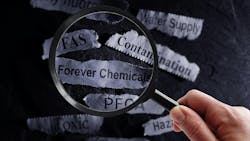EPA Issues More PFAS Test Orders for Chemours, DuPont
By Amanda Joshi
Oct. 9, 2024
3 min read
On Oct. 9, the U.S. Environmental Protection Agency issued the fifth Toxic Substances Control Act (TSCA) Test Order requiring testing on per- and polyfluoroalkyl substances (PFAS) under the EPA’s National PFAS Testing Strategy, the latest action taken under EPA’s PFAS Strategic Roadmap to confront contamination from forever chemicals nationwide.
The action orders Innovative Chemical Technologies, The Chemours Company, Daikin America, Inc., Sumitomo Corporation of Americas, and E.I. Du Pont de Nemours and Company to conduct and submit testing on 3,3,4,4,5,5,6,6,7,7,8,8,8-tridecafluorooctyl prop-2-enoate, also known as 6:2 fluorotelomer acrylate (6:2 FTAc). 6:2 FTAc is used to manufacture plastics, resins, textiles, apparel, leather and other chemicals. Between one million and 20 million pounds are produced per year.
“PFAS in our air, water, and in our bodies cause serious health effects like cancer and heart and liver problems,” said Michal Freedhoff, the assistant administrator for the Office of Chemical Safety and Pollution Prevention in a press release. “That’s why it’s so important for us to collect as much information as we can on these chemicals – to learn more about the potential environmental and human health impacts of PFAS and take any necessary steps to address them.”
Potential Effects of 6:2 FTAc
Studies summarizing 6:2 FTAc exposures to rodents suggest that it causes changes in blood cell counts, liver and kidney size and animal behavior. Further, its chemical structure indicates it may cause cancer.
According to the EPA, PFAS such as 6:2FTAc can build up in our bodies and the environment over time. Even small amounts can significantly contribute to people’s long-term exposure and health risk for cancers, impacts to the liver and heart, and immune and developmental damage to infants and children.
The EPA believes 6:2 FTAc may present an unreasonable risk of injury to health or the environment, given the hazard and exposure concerns for this chemical specifically and for PFAS generally. The information the EPA receives under this order, especially toxicity information, will improve the agency’s understanding of human health effects of 6:2 FTAc and other PFAS with similar structure to 6:2 FTAc. The information will also add to the EPA’s overall knowledge of this category of PFAS, the agency said.
The companies subject to the test order may either conduct the tests as described in the order or provide the EPA with existing information that satisfies the order requirements.
The EPA encourages companies to jointly conduct testing to avoid unnecessary duplication of tests and will also consider possible combinations of tests that cover several required endpoints to reduce time, costs and the use of animal subjects.
PFAS National Testing Strategy
In the National PFAS Testing Strategy, the EPA divided PFAS into smaller categories based on similarities in structure and physical-chemical properties. The agency is issuing test orders for PFAS in specific categories that lack toxicity data to inform its understanding of the potential human health effects.
The EPA has ordered several PFAS tests per the new PFAS testing framework. Previous orders include testing the physical-chemical properties of 2-(N-Methylperfluoro-1-octanesulfonamido)ethanol (NMeFOSE) and the testing of 2,3,3,3-Tetrafluoro-2-(heptafluoropropoxy) propanoyl fluoride (HFPO-DAF), a substance used as a reactant in organic chemical manufacturing.
Sign up for our eNewsletters
Get the latest news and updates
Sponsored Picks
Sponsored
